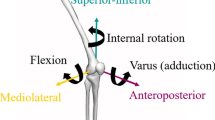Abstract
Effective management of neck pain requires detailed knowledge of cervical muscle structure and function. Information on muscle fibre type assists in determining function; few data exist on the fibre type composition of many cervical muscles. The purpose of this study was to investigate the fibre type composition of longus capitis (LCa) and longus colli (LCo) to provide a better understanding of their function. Muscle sections were harvested unilaterally from LCa (C2–C7) and LCo (C3, C6, T1) in seven female cadavers (mean age 86 ± 9 years). Immunohistochemistry was used to identify type I and type II fibres, and stereology (random systematic sampling) used to determine fibre numbers. Data were assessed using descriptive statistics and one-way ANOVA (significance P < 0.05). Fifty-two sections were assessed (82,785 fibres; mean 1,592 ± 927 per section). LCa had a significantly greater proportion of type I fibres than LCo (64.3 % vs 55.7 %, P = 0.011). The percentage of fibre types varied significantly between individuals in LCa, but not LCo. No significant difference was found in the proportion of type I fibres between cervical levels for either LCa or LCo. LCa and LCo appear functionally different in elderly females, with LCa potentially having a more postural role (higher type I fibre proportion). Fibre types were homogenous throughout each muscle, indicating that contractile function is similar across the length of individual muscles. Further studies across a larger age-span and in males are required to determine whether results are representative of other populations.

Similar content being viewed by others
References
Boyd-Clark LC, Briggs CA, Galea MP (2001) Comparative histochemical composition of muscle fibres in a pre- and a postvertebral muscle of the cervical spine. J Anat 199:709–716
Cagnie B, Dickx N, Peeters I, Tuytens J, Achten E, Cambier D, Danneels L (2008) The use of functional MRI to evaluate cervical flexor activity during different cervical flexion exercises. J Appl Physiol 104:230–235
Cagnie B, Dirks R, Schouten M, Parlevliet T, Cambier D, Danneels L (2011) Functional reorganization of cervical flexor activity because of induced muscle pain evaluated by muscle functional magnetic resonance imaging. Manual Ther 16:470–475
Cornwall J, Stringer M, Duxson M (2011) Function morphology of the thoracolumbar transversospinal muscles. Spine 36:E1053–E1061
Cornwall J, Perry GF, Louw G, Stringer MD (2012) Who donates their body to science? An international, mutlicenter, prospective study. Anat Sci Educ 5:208–216
Doherty T (2003) Invited review: aging and sarcopenia. J Appl Physiol 95:1717–1727
Falla D (2004) Unravelling the complexity of muscle impairment in chronic neck pain. Manual Ther 9:125–133
Falla D, O’Leary S, Fagan A, Jull G (2007) Recruitment of the deep cervical flexor muscles during a postural-correction exercise performed in sitting. Manual Ther 12:139–143
Flowers JM, Hicklin LA, Marion M (2011) Anterior and posterior sagittal shift in cervical dystonia: a clinical and electromyographic study, including a new EMG approach of the longus colli muscle. Movement Disord 26:2409–2414
Javanshir K, Amiri M, Mohseni-Bandpei MA, Rezasoltani A, Fernandez-de-las-Penas C (2010) Ultrasonography of the cervical muscles: a critical review of the literature. J Manip Physiol Ther 33:630–637
Johnson MA, Polgar J, Weightman D, Appleton D (1973) Data on the distribution of fibre types in thirty-six human muscles: an autopsy study. J Neurol Sci 18:111–129
Jull GA (2011) Considerations in the physical rehabilitation of patients with whiplash-associated disorders. Spine 36:S286–S291
Jull G, Barrett C, Magee R, Ho P (1999) Further clinical clarification of the muscle dysfunction in cervical headache. Cephalalgia 19:179–185
Jull GA, Falla D, Vicenzino B, Hodges PW (2009) The effect of therapeutic exercise on activation of the deep cervical flexor muscles in people with chronic neck pain. Manual Ther 14:696–701
Kamibayashi LK, Richmond FJ (1998) Morphometry of human neck muscles. Spine 23:1314–1323
Lexell J, Taylor C, Sjostrom M (1985) Analysis of sampling errors in biopsy techniques using data from whole muscle cross sections. J Appl Physiol 59:1228–1235
Mannion AF, Dumas GA, Cooper RG, Espinosa FJ, Faris MW, Stevenson JM (1997) Muscle fibre size and type distribution in thoracic and lumbar regions of erector spinae in healthy subjects without low back pain: normal values and sex differences. J Anat 190:505–513
Mayoux-Benhamou MA, Revel M, Vallee C, Roudier R, Barbet JP, Bargy F (1994) Longus colli has a postural function on cervical curvature. Surg Radiol Anat 16:367–371
Nitz JC, Burns YR, Jackson RV (1995) Development of a reliable test of (neck) muscle strength and range in myotonic dystrophy subjects. Physiother Theory Pract 11:239–244
Sanders RJ, Jackson CGR, Banchero N, Pearce WH (1990) Scalene muscle abnormalities in traumatic thoracic outlet syndrome. Am J Surg 159:231–236
Sheard PW, Anderson RD (2012) Age-related loss of muscle fibres is highly variable amongst mouse skeletal muscles. Biogerontology 13:157–167
Sirca A, Kostevc V (1985) The fibre type composition of thoracic and lumbar paravertebral muscles in man. J Anat 141:131–137
Uhlig Y, Weber BR, Grob D, Muntener M (1995) Fiber composition and fiber transformations in neck muscles of patients with dysfunction of the cervical spine. J Orthopaed Res 13:240–249
Watson DH, Trott PH (1993) Cervical headache: an investigation of natural head posture and upper cervical flexor muscle performance. Cephalalgia 13:272–284
Wolzak H, van de Rest M, Geurts M, Ter Borg E (2010) Acute calcific tendinitis of the longus colli muscle. J Clin Rheumatol 16:240–241
Ylinen J (2007) Physical exercises and functional rehabilitation of the management of chronic neck pain. Eura Medicophys 43:119–132
Acknowledgments
The authors would like to thank Mr. David Stiles and Mr. Brynley Crosado for their assistance with the cadaveric specimens, and the donors who so graciously bequeathed their bodies. A.M. was supported by an Otago School of Medical Sciences summer scholarship.
Conflict of interest
The authors declare that there are no conflicts of interest.
Author information
Authors and Affiliations
Corresponding author
Rights and permissions
About this article
Cite this article
Miller, A., Woodley, S.J. & Cornwall, J. Fibre type composition of female longus capitis and longus colli muscles. Anat Sci Int 91, 163–168 (2016). https://doi.org/10.1007/s12565-015-0280-3
Received:
Accepted:
Published:
Issue Date:
DOI: https://doi.org/10.1007/s12565-015-0280-3




